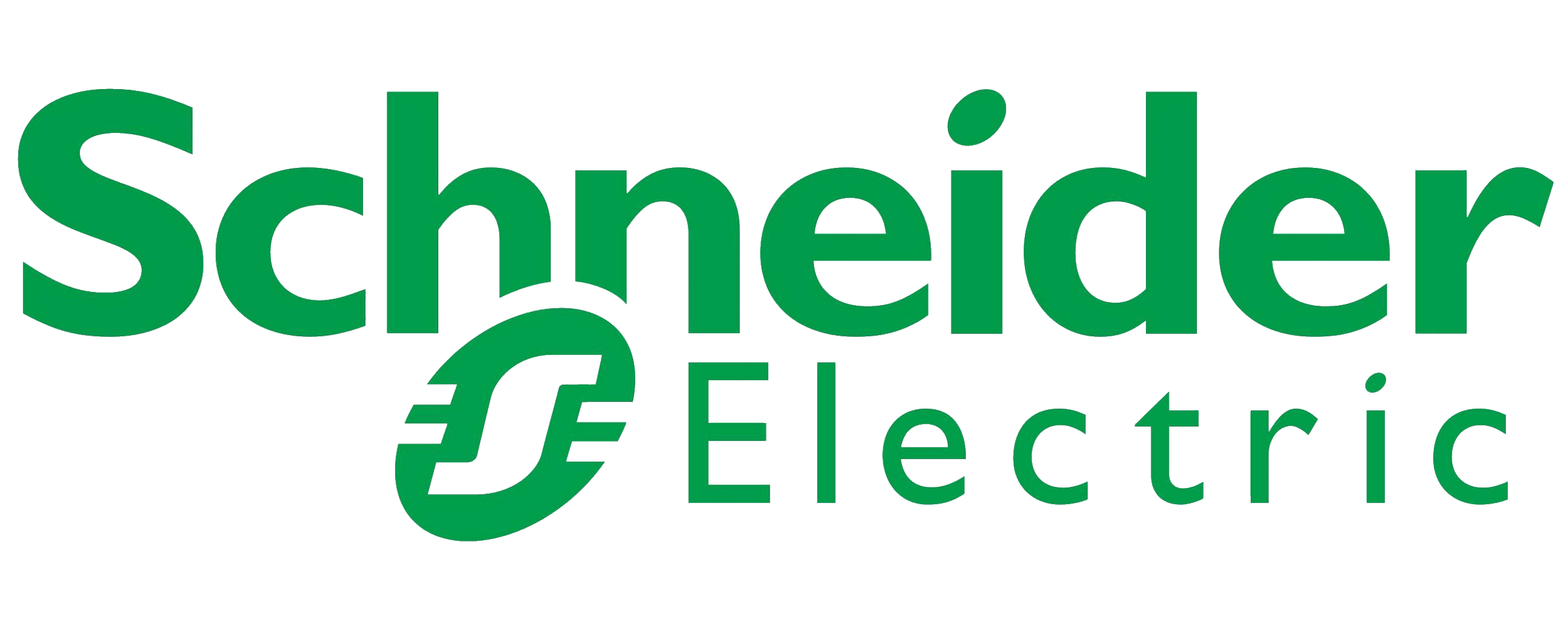Global Isostatic Pressing Market By Offering, By Type, By Applications, By End Users Industry: By Regional & Segmental Forecast, 2023 – 2031
- Industry: Construction & Manufacturing
- Report ID: TNR-110-985
- Number of Pages: 420
- Table/Charts : Yes
- November, 2023
- Base Year : 2024
- No. of Companies : 11+
- No. of Countries : 29
- Views : 10201
- Covid Impact Covered: Yes
- War Impact Covered: Yes
- Formats : PDF, Excel, PPT
In Terms of Revenue, the Global Isostatic Pressing Market Accounted For US$ 7.58 Bn in 2022; Projected to Gain CAGR of 8.1% During 2023 – 2031.
Global Isostatic Pressing Market Overview
Isostatic pressing, also known as cold isostatic pressing (CIP) or high-pressure processing (HPP), is a manufacturing technique used to shape and consolidate materials by applying uniform pressure from all directions. This process is commonly employed in various industries to produce high-quality components with precise dimensions and desirable material properties.
How Isostatic Pressing Works:
Isostatic pressing involves placing a material or workpiece into a flexible or rigid container, typically made of rubber or metal, which can withstand high pressures. The container is sealed, and pressurized fluid (usually water or oil) is introduced into the chamber. The pressure is applied uniformly in all directions, exerting force on the material inside. This isotropic pressure ensures that the material is compressed uniformly, eliminating any internal voids or defects.
Services Segment to Gain Growth at the Fastest Rate in the Global Isostatic Pressing Market During 2023 – 2031
Services include consulting, maintenance, repair, training, or even custom isostatic pressing solutions. Isostatic pressing can be a complex process, and companies may require specialized expertise to optimize their operations and troubleshoot issues. Service providers with technical knowledge can fill this gap. Regular maintenance is crucial for isostatic pressing equipment to ensure its reliability and longevity. Service providers offering maintenance contracts or one-time services can be in high demand. Training programs and ongoing technical support can help companies improve their isostatic pressing processes and maximize equipment’s efficiency. Companies engaged in research and development (R&D) activities may seek services for prototyping and testing using isostatic pressing techniques.
Global Isostatic Pressing Market Revenue & Forecast, (US$ Million), 2015 – 2031

Hot Isostatic Pressing Accounted for a Substantial Market Share in 2022 in the Global Isostatic Pressing Market
Hot isostatic pressing (HIP) is a specialized process used to consolidate and densify materials at high temperatures and pressures, offering unique advantages in various applications. It allows for the production of materials with superior properties, including high density, improved mechanical strength, and enhanced resistance to defects. It is employed in a wide range of industries, including aerospace, medical, automotive, and energy, making it versatile and appealing to various manufacturers.
As industries demand advanced materials for challenging applications, HIP can meet these requirements by processing materials like superalloys, titanium, and ceramics. The success and substantial market share of the HIP category in the isostatic pressing market is further attributed to ongoing advancements in technology, increased demand for high-performance materials, and a growing focus on quality assurance and reliability in manufacturing.
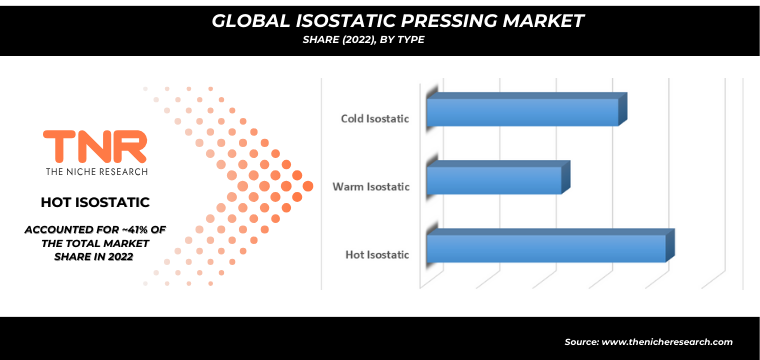
Medical to Gain Fastest Growth Rate in the Global Isostatic Pressing Market
Isostatic pressing is used in the medical field to manufacture components such as dental implants, orthopedic implants, and surgical instruments. The demand for biocompatible materials in medical applications is driving the adoption of isostatic pressing market across the medical sector. Medical devices and implants require high precision and quality to ensure patient safety. Isostatic pressing can produce components with the necessary precision and material integrity. Ongoing research and development in the medical field often require advanced materials and manufacturing techniques, with isostatic pressing playing a significant role in prototyping and testing. Additionally, with an aging global population, there is an increasing demand for medical implants and devices, which is propelling the growing demand of isostatic pressing market.
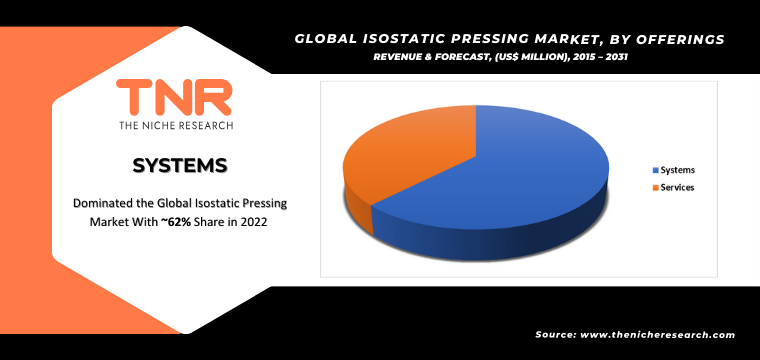 Asia Pacific Region to Gain Fastest CAGR During Forecast Period (2023 – 2031)
Asia Pacific Region to Gain Fastest CAGR During Forecast Period (2023 – 2031)
Asia Pacific has been a hub for industrial growth and manufacturing activities, including aerospace, automotive, electronics, and energy sectors. The increasing demand for high-quality components in these industries can drive the adoption of isostatic pressing market. Countries in the Asia Pacific region, such as China and India, have emerging economies with a growing middle class. This leads to increased consumption and the need for advanced manufacturing processes like isostatic pressing to meet demand. Isostatic pressing is known for its efficiency and minimal waste generation, aligning with sustainability goals, which a key factor driving its growth. Moreover, infrastructure development projects in the region often require specialized components. Isostatic pressing provide solutions for manufacturing these components efficiently.
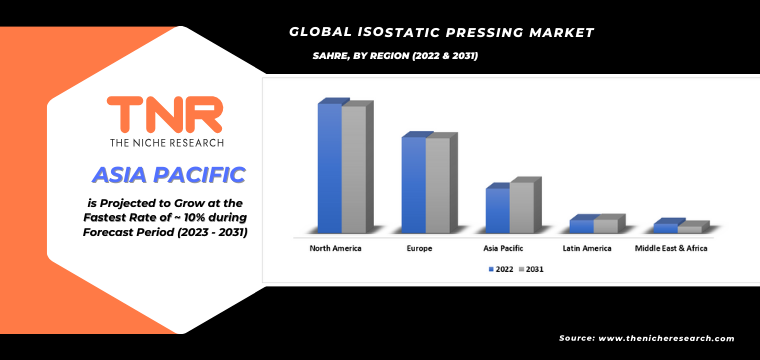
Competitive Landscape
A few of the key players operating in the global isostatic pressing market are:
- Aalberts Surface Technologies
- Aegis Technology
- American Isostatic Presses (AIP)
- Bodycote
- EPSI
- Fluitron, Inc
- HIPERBARIC
- Isostatic Pressing Services
- Kennametal Inc.
- Kobe Steel, Ltd.
- Nikkiso Co., Ltd.
- Paulo
- Pleiger Maschinenbau GmbH & Co. KG
- Pressure Technology, Inc.
- Quintus Technologies AB.
- Other Market Participants
Global Isostatic Pressing Market
| Report Specifications | Details |
| Market Revenue in 2022 | US$ 7.58 Billion |
| Market Size Forecast by 2031 | US$ 13.2 Billion |
| Growth Rate (CAGR) | 8.1% |
| Historic Data | 2015 – 2021 |
| Base Year for Estimation | 2022 |
| Forecast Period | 2023 – 2031 |
| Report Inclusions | Market Size & Estimates, Market Dynamics, Competitive Scenario, Trends, Growth Factors, Market Determinants, Key Investment Segmentation, Product/Service/Solutions Benchmarking |
| Segments Covered | By Offerings, By Type, By Applications, By End User Industry |
| Regions Covered | North America, Europe, Asia Pacific, Middle East & Africa, Latin America |
| Countries Covered | U.S., Canada, Mexico, Rest of North America, France, The UK, Spain, Germany, Italy, Nordic Countries (Denmark, Finland, Iceland, Sweden, Norway), Benelux Union (Belgium, The Netherlands, Luxembourg), Rest of Europe, China, Japan, India, New Zealand, Australia, South Korea, Southeast Asia (Indonesia, Thailand, Malaysia, Singapore, Rest of Southeast Asia), Rest of Asia Pacific, Saudi Arabia, UAE, Egypt, Kuwait, South Africa, Rest of Middle East & Africa, Brazil, Argentina, Rest of Latin America |
| Key Players | Aalberts Surface Technologies, Aegis Technology, American Isostatic Presses (AIP), Bodycote, EPSI, Fluitron, Inc, HIPERBARIC, Isostatic Pressing Services, Kennametal Inc., Kobe Steel, Ltd., Nikkiso Co., Ltd., Paulo, Pleiger Maschinenbau GmbH & Co. KG, Pressure Technology, Inc., Quintus Technologies AB., Other Industry Participants |
| Customization Scope | Customization allows for the inclusion/modification of content pertaining to geographical regions, countries, and specific market segments. |
| Pricing & Procurement Options | Explore purchase options tailored to your specific research requirements |
| Contact Details | Consult With Our Expert
Japan (Toll-Free): +81 663-386-8111 South Korea (Toll-Free): +82-808-703-126 Saudi Arabia (Toll-Free): +966 800-850-1643 United Kingdom: +44 753-710-5080 United States: +1 302-232-5106 E-mail: askanexpert@thenicheresearch.com
|
Global Isostatic Pressing Market
By Offering
- Systems
- Services
By Type
- Hot Isostatic
-
- Small-Sized HIP
- Medium-Sized HIP
- Large-Sized HIP
- Warm Isostatic
- Cold Isostatic
-
- Dry Bag Pressing
- Wet Bag Pressing
By Applications
- Castings Densification
- Powder Metallurgy
- Additive Manufacturing & 3D Printing
- Diffusion Bonding and Cladding
- Intermetallics
- Others
By End Users Industry
- Automotive
- Aerospace
- Defense
- Medical
- Chemicals
- Energy & Power
- Oil and Gas
- Semiconductors and Electronics
- Manufacturing
- Research and DevelopmentIsostatic Pressing Market
- Others
By Region
- North America (U.S., Canada, Mexico, Rest of North America)
- Europe (France, The UK, Spain, Germany, Italy, Nordic Countries (Denmark, Finland, Iceland, Sweden, Norway), Benelux Union (Belgium, The Netherlands, Luxembourg), Rest of Europe)
- Asia Pacific (China, Japan, India, New Zealand, Australia, South Korea, Southeast Asia (Indonesia, Thailand, Malaysia, Singapore, Rest of Southeast Asia), Rest of Asia Pacific)
- Middle East & Africa (Saudi Arabia, UAE, Egypt, Kuwait, South Africa, Rest of Middle East & Africa)
- Latin America (Brazil, Argentina, Rest of Latin America)
Global Isostatic Pressing Market Report Outline
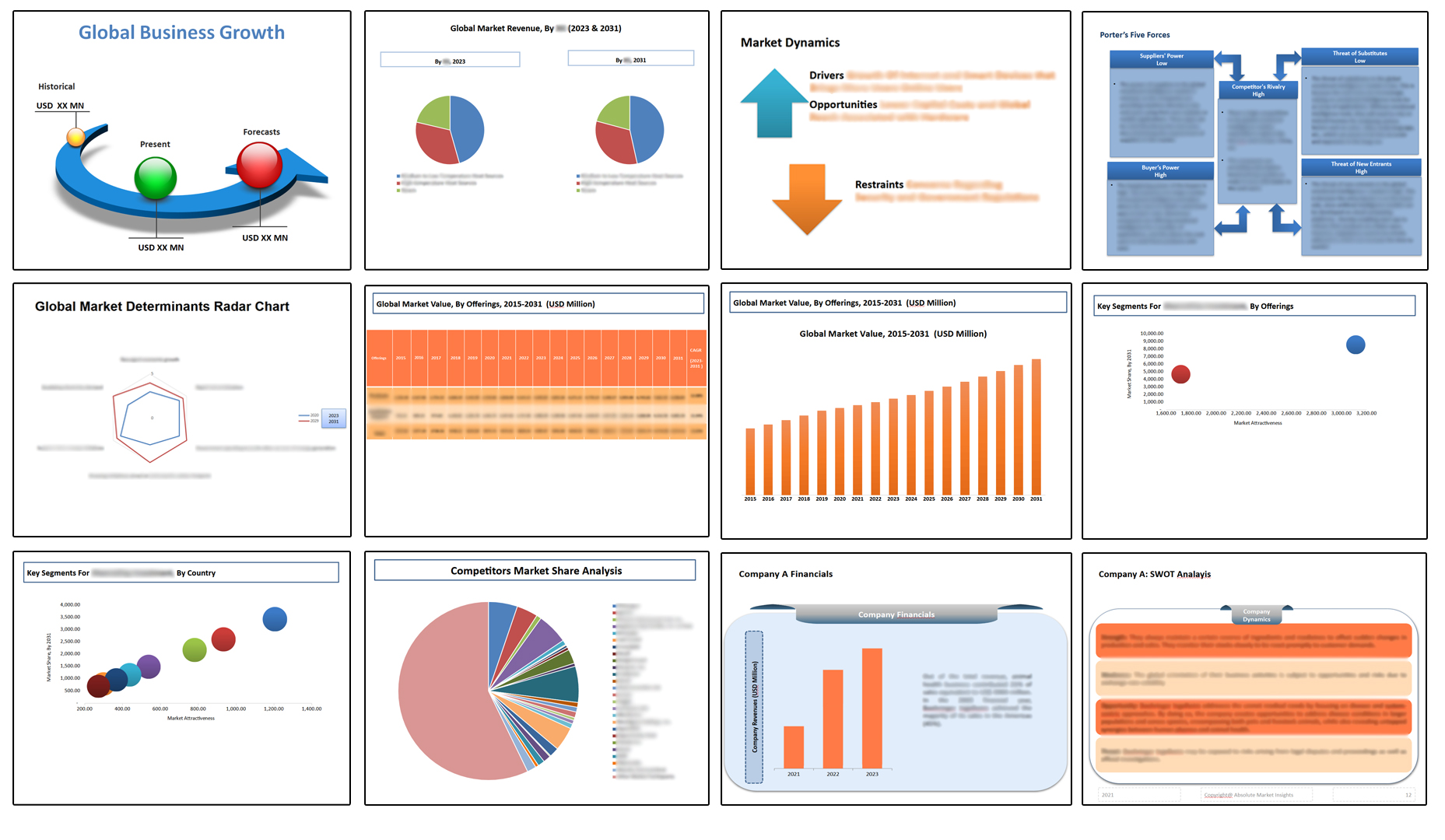
Table of Contents
**Exclusive for Multi-User and Enterprise User.
Global Isostatic Pressing Market
By Offering
By Type
By Applications
By End Users Industry
By Region
**Note: The report covers cross-segmentation analysis by region further into countries
The Niche Research approach encompasses both primary and secondary research methods to provide comprehensive insights. While primary research is the cornerstone of our studies, we also incorporate secondary research sources such as company annual reports, premium industry databases, press releases, industry journals, and white papers.
Within our primary research, we actively engage with various industry stakeholders, conducting paid interviews and surveys. Our meticulous analysis extends to every market participant in major countries, allowing us to thoroughly examine their portfolios, calculate market shares, and segment revenues.
Our data collection primarily focuses on individual countries within our research scope, enabling us to estimate regional market sizes. Typically, we employ a bottom-up approach, meticulously tracking trends in different countries. We analyze growth drivers, constraints, technological innovations, and opportunities for each country, ultimately arriving at regional figures.Our process begins by examining the growth prospects of each country. Building upon these insights, we project growth and trends for the entire region. Finally, we utilize our proprietary model to refine estimations and forecasts.
Our data validation standards are integral to ensuring the reliability and accuracy of our research findings. Here’s a breakdown of our data validation processes and the stakeholders we engage with during our primary research:
- Supply Side Analysis: We initiate a supply side analysis by directly contacting market participants, through telephonic interviews and questionnaires containing both open-ended and close-ended questions. We gather information on their portfolios, segment revenues, developments, and growth strategies.
- Demand Side Analysis: To gain insights into adoption trends and consumer preferences, we reach out to target customers and users (non-vendors). This information forms a vital part of the qualitative analysis section of our reports, covering market dynamics, adoption trends, consumer behavior, spending patterns, and other related aspects.
- Consultant Insights: We tap into the expertise of our partner consultants from around the world to obtain their unique viewpoints and perspectives. Their insights contribute to a well-rounded understanding of the markets under investigation.
- In-House Validation: To ensure data accuracy and reliability, we conduct cross-validation of data points and information through our in-house team of consultants and utilize advanced data modeling tools for thorough verification.
The forecasts we provide are based on a comprehensive assessment of various factors, including:
- Market Trends and Past Performance (Last Five Years): We accurately analyze market trends and performance data from preceding five years to identify historical patterns and understand the market’s evolution.
- Historical Performance and Growth of Market Participants: We assess the historical performance and growth trajectories of key market participants. This analysis provides insights into the competitive landscape and individual company strategies.
- Market Determinants Impact Analysis (Next Eight Years): We conduct a rigorous analysis of the factors that are projected to influence the market over the next eight years. This includes assessing both internal and external determinants that can shape market dynamics.
- Drivers and Challenges for the Forecast Period:Identify the factors expected to drive market growth during the forecast period, as well as the challenges that the industry may face. This analysis aids in deriving an accurate growth rate projection.
- New Acquisitions, Collaborations, or Partnerships: We keep a close watch on any new acquisitions, collaborations, or partnerships within the industry. These developments can have a significant impact on market dynamics and competitiveness.
- Macro and Micro Factors Analysis:A thorough examination of both macro-level factors (e.g., economic trends, regulatory changes) and micro-level factors (e.g., technological advancements, consumer preferences) that may influence the market during the forecast period.
- End-User Sentiment Analysis: To understand the market from the end-user perspective, we conduct sentiment analysis. This involves assessing the sentiment, preferences, and feedback of the end-users, which can provide valuable insights into market trends.
- Perspective of Primary Participants: Insights gathered directly from primary research participants play a crucial role in shaping our forecasts. Their perspectives and experiences provide valuable qualitative data.
- Year-on-Year Growth Trend: We utilize a year-on-year growth trend based on historical market growth and expected future trends. This helps in formulating our growth projections, aligning them with the market’s historical performance.
Research process adopted by TNR involves multiple stages, including data collection, validation, quality checks, and presentation. It’s crucial that the data and information we provide add value to your existing market understanding and expertise. We have also established partnerships with business consulting, research, and survey organizations across regions and globally to collaborate on regional analysis and data validation, ensuring the highest level of accuracy and reliability in our reports.




